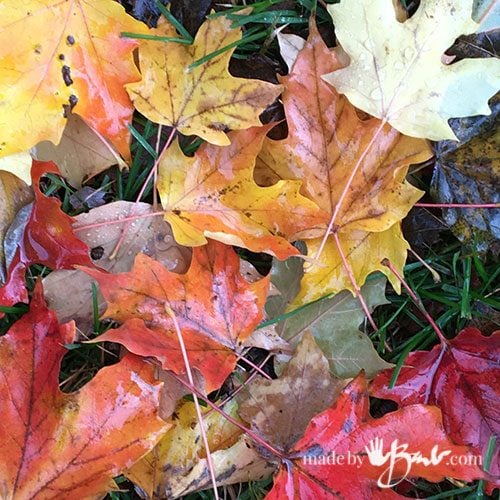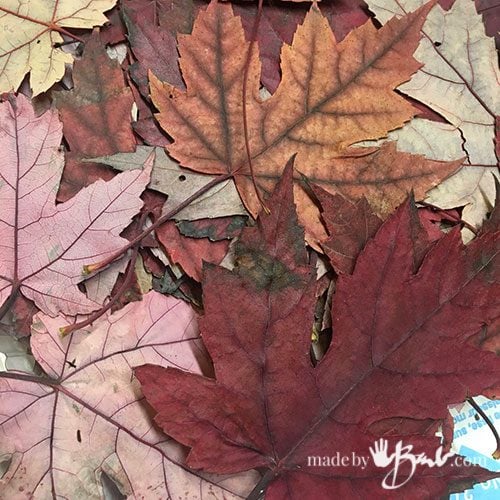How to Store Leaves for Eco Printing

Winters in Canada are long; so just like a squirrel I have to think ahead if I want to be able to eco print all year long. Let me show you how to store Leaves for Eco printing so that you are ready whenever the urge hits and avoid some common mistakes.

Enjoy the Collecting:
One of the fabulous side effects of eco printing is that you need to go outside… for a good reason! It also makes you appreciate what is around you in ways that you never have before! Leaf collecting has given my dog and I some wonderful relaxing adventures. Often I will have to explain to others what this wonderful art form is so be sure to wear one of your scarves (or one of mine)

‘Really looking at the species of trees around you, while breathing in the fresh air is a healthy habit! Up close and personal with such intricate details can take some of that daily stress away. Quiet times strolling along and reflecting; how can such biological magic just ‘pop’ out each year?!

I am blessed with much ‘green’ around me; especially my beloved sumac & many many maples. It fills many roadsides with green and no one thinks they are precious… except me.

What NOT to do:
When I first started collecting I used books to press my leaves in. It seemed pretty logical however they would get too full and the books started to absorb the moisture. Also, since they are bound by the spine the flattening pressure was also not even.

My Preferred Method to Store Leaves:
I like to be able to keep some order to my studio; which if you Eco Print you know can be a challenge. For simplicity sake I collected a large amount of newspapers and cut them to a common size. I also cut a bunch of card board into the same sizes.
Yes, it’s pretty simple to just press them between the paper but they do not all have the same moisture content.

Sumac is quite fleshy so it can easily get mouldy therefore using multiple sheets between layers is much better. Do not have the leaves overlap either. I use the cardboard as a way to keep things flat and also to keep the species separated.
Applying pressure seems logical too but it actually stops the drying process somewhat as it locks in the moisture which will cause mould. I don’t stack more than 6″ of the layers. Flipping the stack every (day or so) allows the layers get air flow and even out the weight of the stack.

My main purpose is to keep them flat while drying, but they don’t need to be ‘crazy’ flat. Keeping bags full of freshly found leaves in outside sheds can work as well but I am fussy about how my arrangement and I prefer to see the them flat.
Fall has such an abundance of leaves (and rain) so large amounts can be collected, but letting them dry somewhat is a good idea.

How many leaves do you need?!
I get that question all the time! That ‘crazy lady that looks like she is cleaning up the whole park’ will be happy once she has a good stockpile. I tend to use a lot of this free matter in my designs and scarves so I ‘overstock’.
I now know where all the ‘best’ trees are. Spring foliage is tender and will print a bit different than the more developed in the later season but I still use it. They can be so fresh that they wilt in no time so quick printing or saving is needed. Even having something to sandwich them right away helps.
The colours of the leaves don’t necessarily print that way; that’s why it’s such an interesting art form; sort of like painting without knowing the colour on your brush.

Keep Checking:
Tip: don’t stack and forget, keep checking as not all species of leaves are the same in the drying time. I have lost much sumac to mould because of this.

After I have them dried I do like to keep organized and sort them into containers. Most will keep their colour quite nicely and I avoid overly decayed leaves.

Neat and Tidy:
My preference is to store leaves by specie and in visible containers. I don’t buy so I just reuse those bakery and disposable ones from anywhere. Sure, all the same size would be good but I use what I come across.

Being able to see them is much better when I do my ‘choosing’ for the day. It’s the best part after all the work of drying and storing. I want to keep them in tact without loosing tips so handling is gentle. I feel ‘rich’ with my stockpile… like a big assortment of ‘paint’.
Other Options:
Some printers like to store leaves in the freezer but I think it would be so complicated and using energy seems wasteful. The fridge will keep fresh leaves from getting mouldy if I need some time until I can press them.
Go! Go outside and get some leaves…
Check out my resources under the ‘Home’ menu and amaze yourself! And let me quoin this:
“Each bundle I wrap feels like a gift to myself, each time I unroll one the wonder and delight is as fresh as it was the very first time. I hope it is so for you, too” ~ India Flint
Thank you for this. I am definitely game. The thing is I would like to use Tomoe River paper. 🤔 My one ither concern is getting the metal I read about in ylur other post for dyeing. Not sure how/where that would come from. Vinegar is no problem, but that metal 👀😵.
You can use some rust water made with rusty items until it turns orangey. You can also source some iron sulphate from dye suppliers or even garden centres. Fun stuff!
Would you please tell me, AFTER you have your stored/dried leaves, and you want to use them for eco-dying…do you re-wet the leaves? in water? an an alum mordant water? I will be working with middle school students to eco-dye on watercolor paper AND on silk. I was hoping to have them collect the leaves themselves, but the class will be in December, and I live in Southern Oregon and our leaves are mostly fallen already! and help would be so appreciated, thank you, Gretchen Vos, Ashland, OR
I rehydrate the leaves in a shallow tray with warm to hot water depending how quickly I want to use them. I don’t use too much water as I don’t want to wash out the tannins. You could also add a bit of vinegar and some iron sulphate depending where you are adding the iron into the technique. So many choices! This may also help
I also live in the northwest, so it’s difficult to find good foliage in the winter. I was able to preserve all my beautiful diverse foliage from the seasons by soaking them In glycerin and water mixture or two days. This not only preserves the leaves but keep them pliable. So many of the leaves I flattened in the past crumbled when using this with my Gelli press. You can find glycerin at most hobby stores or on-line.
After soaking the plant matter for several days, I place them between paper towels and flattened inside a book. I’m using the plant matter over and over again.
Oh, yes. I remember doing something like that with the glycerine and salal leaves. I know how the glycerine works since I have made soaps and lotions/creams for myself. I’m not sure though how this will work with the fact that the colour comes from the tannin releasing from the leaf, not as a texture or relief method. I am curious about that Gelli printing process and might look into it someday. The leaves that I have saved and dried are rehydrated before using so they fare quite well. Thanks for info!
Thank you for this wonderful post! I’ve been troubled trying to work out how I can eco-print over the winter here in England; I was trying to overcomplicate it, so good to know flattening leaves is an option.
I’m doing a fine art degree and have been so busy writing essays this month I haven’t been able to go out, and now there are no leaves left! 🙁
Do you find that there is a difference between the effect in your prints due to the age of the leaves? I would’ve thought that fresher leaves can leave a different effect, presuming the tannin levels change over time?
Thanks again and all the best!
Fay.
I don’t do extensive tests so that’s hard to answer. If the leaves dry well with no molding than they do print pretty well as if they were fresh. But also some early spring leaves do not print that fresh. Dark autumn leaves (red, orange) do print dark, and I sometimes wonder if they somewhat age a bit more. For that reason I try to collect them at early stages of colour change. It really all depends on what you are looking for. And as you have probably heard doing tests is the best way of knowing as all leaves are not the same.
I want so badly to use this blog as a resource but the sheer amount of ads makes it unbearable and unreadable. I hope the advertising money was worth it. I guess I’ll go to the library instead.
I’m sorry you think that. If it was my choice, I wouldn’t have ads either! You may want to try different browsers/devices. It’s always a trade-off as many sites do charge for information or subscriptions. Trust me, the revenue in this niche often makes me question continuing to provide for free. Many Eco printers run workshops that can run in $200/day. Good luck in the library…
Dear Barb!
I love your work and I’m deeply grateful that you share your experience!
That eco printing virus infected me, too.
It’s autumn now and I feel that “squirrel energy” to run around and collect leaves to store 😉
Some already lost their colours and are completely brown now, e.g oak or maple leaves.
Are they still worth to collect and dry them for winter?
It’s difficult to say exactly. My oak do not give me much but the maple leaves do. This post may help. The dark red leaves print very dark, the brown ones don’t give much colour but could be used with an iron blanket for definition. I look for some colour variations and bright, not to dark colours. ‘But, it’s an experimentation issue. Good luck
Hello! I’m just getting into eco printing! I’m excited! I love the woods and to craft/create! Found your page and enjoyed it! Thanks
Welcome! You will get hooked as there are more & more ways to use nature to print with!